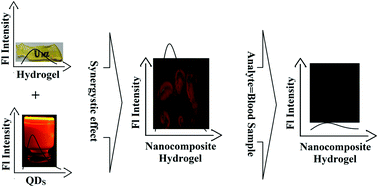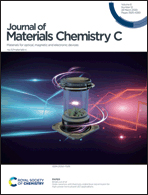Highly sensitive and strongly fluorescent gum tragacanth based superabsorbent hydrogel as a new biosensor for glucose optical detection
Abstract
In this study, a highly sensitive superabsorbent hydrogel biosensor for blood glucose was prepared based on gum tragacanth (GT) nanoparticles, acrylic acid (AA) monomer, N,N′-methylenebisacrylamide (MBA) and fluorescein O,O′-diacrylate (FlA-DA) as cross-linkers. Then, CdTe quantum dots (QDs) and glucose oxidize (GOx) enzyme bioreceptor were immobilized within the cross-linked network of the hydrogel. The prepared biosensor was highly fluorescent due to the synergism process between the QDs and FlA-DA. The biosensor was able to perform enzyme-catalyzed oxidation of glucose to produce H2O2, a product that subsequently quenched the fluorescence emission. The quenching rate was a function of glucose concentration. The detection limit and the Michaelis–Menten constant (KM) of the present system were found to be the excellent values of 0.1 and 1.35 mM, respectively, which were much lower than those of conventional gel materials. This new device has also shown satisfactory reproducibility and accuracy with real blood samples without pretreatment. The results indicate that this new highly fluorescent biosensor with simple fabrication offers high immobilization for the fluorescent reporters and bioreceptors, and can be a suitable diagnostic device for biomedical applications.



 Please wait while we load your content...
Please wait while we load your content...